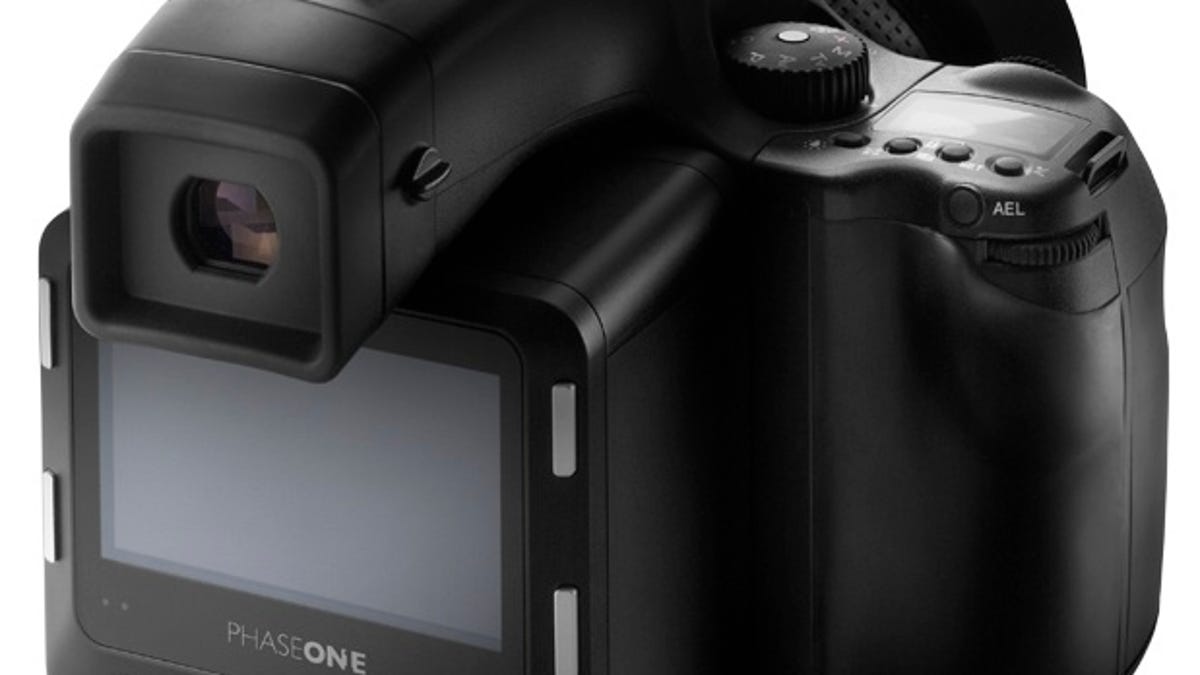Phase One pushes ahead with 80-megapixel sensor
In the rarefied air of medium-format digital photography, Phase One aims to stay competitive with a new family of image sensors. Also: USB 3 and a touch screen.

Phase One, the Danish maker of high-end digital camera gear, announced a new top-end product: an image sensor with a whopping 80 megapixels.
The IQ180 is a digital back, which consists of an image sensor, viewing screen, and associated electronics housed in a removable module that fits on the back of a medium-format camera body such those from Phase One-controlled Mamiya. The medium-format market, which consists largely of photographers shooting expensive subjects such as fashion models and jewelry, is a demanding one willing to pay a premium for the very detailed images made possible with medium-format gear. Phase One's digital camera backs cost tens of thousands of dollars.
The medium format market was slower to move from film to digital than the compact or SLR markets, but when it did, the change proved disruptive. Phase One came to power with the digital transition. But it's by no means assured an easy future in a premium segment. For one thing, product sales volume here is measured in the hundreds or thousands of units, not millions, and for another, there are still competitors.
Along with longtime rival medium-format specialist Hasselblad, which is becoming newly aggressive with a relatively low-priced 40-megpixel HD4 model, Phase One has faced steadily more powerful SLR competition from Nikon and Canon. Their top-end models today have resolutions of 24 megapixels and 21 megapixels, respectively. Those cameras' sensors are smaller, but Canon and Nikon benefit from research and development spread across a vastly larger customer base and from plenty of loyal users moving up through the ranks.
And a new arrival is Pentax, which has just re-entered the medium-format with its first digital model. It, too, has abundant mainstream experience and technology such as autofocus and metering it can translate directly to the medium-format line.
Phase One is staying on the technology curve that comes with the digital realm, though. Here's what's coming along to unseat update products like Phase One's previous high-end back, the 60-megapixel P65+, and the 40-megapixel P45+:
First, it's got three new digital backs, the 80-megapixel IQ180, the 60-megapixel IQ160, and the 40-megapixel IQ140. All three use new CCD (charge-coupled device) sensors. They're built by Dalsa, which has become a favored supplier in the medium-format realm, but Phase One said they're different models from the 80-megapixel models announced in September for Leaf Aptus-II backs from Phase One's Leaf subsidiary.
The IQ180 and IQ140 measure a whopping 53.9x43.4mm; the 40-megapixel IQ140 measures 44x33mm. Because of the economics of chipmaking, larger sensors are much more expensive to build than smaller ones--a big reason that mainstream SLRs have smaller image sensors than "full-frame" models with sensors measuring the 36x24mm size of a frame of 35mm film.
As important as megapixels but often overlooked is dynamic range, which measures the spread of light and dark the sensor can capture. All three new backs have a dynamic range of 12.5 f-stops, Phase One said. Dynamic range in general is often in opposition with high megapixel counts, so it's a challenge to maintain this attribute as sensor resolutions increase.
As with predecessors, the sensors capture 16 bits of color data per pixel. Competing SLRs today capture 14 bits per pixel, and lower-end models only 12 bits per pixel. The larger number means finer tonal gradations, at least in theory.
Also as with the earlier models, the new IQ line can be used in a Sensor Plus mode, which combines pixel data to produce images at a quarter the resolution but at double the light sensitivity. At full resolution, the sensors cover a sensitivity range of ISO 50 to 800, but in Sensor Plus, they go from ISO 200 to 3,200.
It's not just about sensors, though. The new line comes with a new, high-resolution LCD with a 1.15-megapixel resolution Phase One calls "retina type," presumably in an effort to ride on the coattails of enthusiasm for the similarly named display on Apple's iPhone 4. And for the first time, it's now a touch screen, with the ability to pan and zoom images--a welcome addition if implemented well, since controlling the sensor can be awkward otherwise using just its four buttons.
The new products also have a faster memory interface; the cameras can keep up with continuous shooting now. That's made more challenging by the 80-megabyte files the IQ180 produces, but it's offset by the fact that such cameras typically shoot one photo per second or slower.
A final new feature is the addition of USB 3.0, the new version of the Universal Serial Bus specification that's about 10 times faster than the prevailing USB 2.0 that's been around for a decade. It continues with earlier models' Firewire 800 connection, too, for tethered shooting in which data is recorded directly on a computer rather than on memory cards.
The IQ180 is scheduled to arrive at the end of April, and the IQ160 and IQ140 at the end of May.

